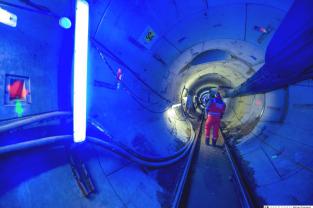The hydraulic gallery is intended to recover 5 to 10 % from the warm waters of the Gravelines nuclear power plant and to transfer it to the LNG terminal, in order to heat the liquefied gas. The gallery access shaft, 16 m in diameter and 50 m deep, was excavated inside a diaphragm wall (65 m deep).
The tunnel, 5 km long and 3.8 m in exterior diameter (3 m in interior diameter), was excavated with an earth pressure balance (EPB) tunnel boring machine (TBM). Its complete alignment is located in the Flanders clays, a very homogeneous overconsolidated layer. Progress was satisfactory until the TBM suffered damage in April 2014, when it was still under the outer harbour. The problem was a failure in the link (dowels) between the gear box and the TBM cutting wheel, making it impossible to continue excavating without repair. Moreover, the repair works had to be done from the front of the TBM. The consortium chose to proceed by excavating a bypass tunnel about 25 metres long using conventional method, starting from the back of the TBM skirt and joining the front part, with creation of a disassembly chamber ahead of the cutting wheel.
TERRASOL was in charge of the supervision of geotechnical works for the bypass tunnel on behalf of COFIVA. The contractor worked in an extremely confined space.
After a six-month interruption only (part of this delay was made up subsequently), the TBM resumed its excavation, in a sensitive site where the TBM was not allowed to generate surface settlement of more than 1 cm.
The excavation works were completed by March 2015, and the instrumentation equipment installed by the consortium on the power plant site and monitored jointly by BRS and TERRASOL showed that surface settlements generated by the TBM did not exceed 6 mm.
The last step was to connect the tunnel to the 12 siphons of the release basins of the nuclear power plant. This extremely delicate connection method was defined by the consortium and required special equipment as well as small section earthworks within a confined space 1.3 m in diameter.
TERRASOL worked on behalf of COFIVA to validate the connection principles and monitor on-site operations.
The gallery was filled with water in August 2015.
Terrasol’s achievements:
- Supervision of works for the bypass tunnel and the disassembly chamber
- Supervision of works for the connection of the release basins
 Agent Access
Agent Access 




